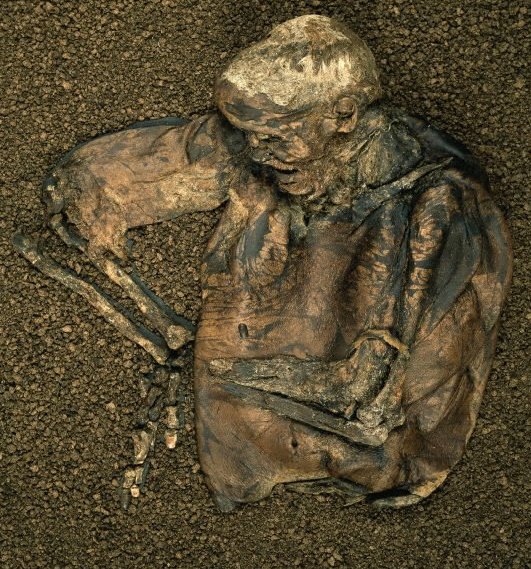Lindow Man
Interview with
 Now the temporary exhibit that Steve McLean mentioned, the Lindow Man sounded fascinating. So Meera Senthilingam met Dr Sarah Glynn, who's another Manager at the Museum, to find out the history behind this amazing exhibit.
Now the temporary exhibit that Steve McLean mentioned, the Lindow Man sounded fascinating. So Meera Senthilingam met Dr Sarah Glynn, who's another Manager at the Museum, to find out the history behind this amazing exhibit.
Sarah - Well, Lindow Man is Britain's most important and most complete bog body. He was found 25 years ago in Lindow Moss which is in Cheshire in Manchester. And he was found by peat cutters who were cutting the peat in the Moss, originally he was found because one of the cutters was throwing something off the conveyor belt that they thought was just a log. It turned out to be a leg. The police, the archaeologists were all brought in, and Lindow Man was taken out in a full piece of peat and excavated in the lab in London. He was a very heavily forensically researched. We can tell loads about his final days, his final hours, how he died. We know that he suffered three key injuries. He has a blow to the head. He has a garrotte or a sinew round his neck may have been used as a garrotte. He also has a broken neck and he also has some potential stab wounds.
Meera - That's quite a death.
Sarah Glenn - Yeah, quite, quite a nasty way to go. We know that the blow to the head didn't kill him because CT data shows that his brain had started to heal. His head had swollen and bruised basically so he must been alive for enough hours for that to happen. And the work eventually showed, that it was the fracture to the neck which was the fatal injury. The interesting thing about Lindow Man is that we know already his detailed items about how he died. What we don't know is why did he die? Was it a ritual sacrifice? Was he executed as an example to the community? Or was he just a really unfortunate murder?
Meera - So how would scientists go about finding that out?
Sarah - Well, archaeologists and the forensic scientists still study Lindow Man up until the present day. At around the time that Lindow Man died, there are quite a lot of bog bodies across Western Europe and often they have suffered three deaths as it were so similar to Lindow Mans three significant injuries and even things like swords that were thrown into bogs as offering to the gods. They were sometimes killed three times so they might be bent three ways. We don't know exactly what this all meant but it was clearly something quite significant.
Meera - Yeah, it's a very interesting pattern.
Sarah - And it's certainly, for me, the strongest argument for why is probably a ritual sacrifice but we can't be sure and we can never be sure because there are no written records from the time. But what we do know is that Lindow Man was very well looked after physically. So he has manicured fingernails, he has hair that has been cut into a very fetching mullet and he was probably about 25 years old.
Meera : How are you using the exhibition here then to teach the people about Lindow Man and what the science involved in finding out about his demise and his life is about.
Sarah - Well, this exhibition is all about as presenting the visitors with the evidence that we've got and asking them to make up their own minds about how he died. We've even got some cutting edge technology which was developed by Newcastle University's Culture lab department and which is a multi use of touch table and you can investigate in details some of the forensic data that was collected at the time: x-rays, CT scans. You can even run simulations to see particular weapons in action so can decide for yourself what might have killed him. And really, because we don't know, we're throwing it open to our visitors to say here's the data, you decide. You make your interpretation, which is just as valid as those of the archaeologist and the forensic scientists.
Meera - That's a nice touch to think that they could help contribute to a quite complex mystery.
Sarah - We really want to involve our visitors in our exhibitions and particularly for this where we just don't know. It's a wonderful way of doing it.
- Previous The Great North Museum
- Next Protection from Flooding









Comments
Add a comment